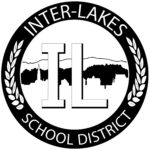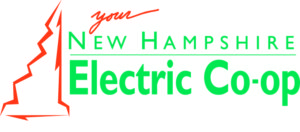How Laker Blue Went Green and Became a State Energy Leader
By Seth Wheeler, New Hampshire Electric Cooperative
Working with New Hampshire Electric Cooperative (NHEC), Honeywell and other energy professionals, the Inter-Lakes School District (ILSD) is on track to become the greenest, most energy-diverse school district in the state of New Hampshire. The path it took to get there holds lessons for school districts across New England.

The silo that feeds the new wood pellet boiler at the Inter-Lakes Elementary School will soon become the blank canvas for a student art project. Behind the silo are solar panels that power the school’s solar thermal hot water system. Photo: Seth Wheeler
ILSD is a cooperative school district serving approximately 1,060 students from pre-school to 12th grade from the towns of Meredith, Center Harbor, and Sandwich. Like many school districts in the construction boom years of the 1980s and 1990s in New Hampshire, ILSD was less concerned about energy efficiency than it was about making space to accommodate a student population that was growing larger every year.
But as growth slowed and gave way to flat or declining student enrollment, the school district leadership faced the hard reality 10 years ago that its facilities and energy infrastructure were in disrepair, and costing taxpayers thousands in wasted energy costs. In response, the School Board, building administrators and the community came together around a shared vision of a school district that would become a model of energy efficiency with a diverse range of renewable energy. It would also seek to integrate that vision with its classroom curriculum, providing its students with experiential learning opportunities.
From a practical standpoint, the school district divided its energy and facilities goals into two phases. The first phase would focus on the district buildings – weatherization, lighting upgrades, replacement of inefficient and failing HVAC systems, and building controls. The second phase of improvements has built on the success of Phase I and opened up a range of opportunities that is diversifying the way the district powers its facilities and its students’ education.
The goal for Phase I improvements was simply to climb out of the hole that was rapidly filling with wasted energy and money. To that end, most of Phase I work was focused on upgrading or replacing heating and ventilation equipment, as well as building-envelope improvements. In a precursor to Phase II improvements, Phase I also included ILSD’s first venture into renewable energy: a 16 MMBTU-per-year solar thermal hot water system that supplemented an existing oil-fired domestic hot water system. ILSD also performed lighting efficiency upgrades on more than 1,000 lights and installed occupancy sensors in key areas. All told, Phase I was a $2.3 million project that will be entirely paid for over 15 years by grants and the energy savings generated by the efficiency improvements. It reduced oil consumption by 50% (48,000 gallons/yr.), electric consumption by 38% (700,546 kWh/yr.), and set the stage for the Phase II improvements that will reduce oil consumption to near zero by 2017.
Phase II projects are even more ambitious and include:
Inter-Lakes High School
- Replacement of 638 interior lights with LED lamps; install occupancy sensors
- Installation of new 1.7 MMBTU/hr output wood pellet-fired boiler system
- Installation of new 132 kW (AC) grid-tied photovoltaic system with system monitoring; installation of energy kiosk at high school to display real time production data and carbon offsets
- Replacement of rooftop energy recovery unit system
- Installation of economizer, door heaters and electronically commutated motors in cafeteria coolers
- Installation of heat pumps in library.
Inter-Lakes Elementary School
- Replacement of 847 interior and exterior lights with LED lamps
- Installation of new 1.7 MMBTU/hr output wood pellet-fired boiler system
- Installation of new 156 kW (AC) grid-tied photovoltaic system with system monitoring; installation of energy kiosk at elementary school to display real time production data and carbon offsets
- Installation of 73 MMBTU/yr solar thermal hot water system
- Removal and replacement of all existing windows and exterior doors
- Installation of economizer, door heaters and electronically commutated motors in cafeteria coolers.
Sandwich Central School
- Installation of new 100 kW (AC) grid-tied photovoltaic system; installation of energy kiosk at school to display real time production data and carbon offsets.
All told, the school district will have cut its energy costs by more than $170,000 per year when Phase II projects are completed.
 NHEC is proud to have played a role in the success of the Inter-Lakes School District’s energy goals. During the development of Phase II projects, NHEC Energy Solutions program administrators identified refrigeration and lighting upgrades that enabled the district to receive $55,500 in NHEC incentives from its Municipal Energy Efficiency Program towards efficiency investments that will provide savings of $23,548 per year. Further, NHEC provided project financing of $35,327 through its Smart START Program for lighting and refrigeration measures installed during 2014. The Smart START Program allows NHEC members to install energy efficiency measures with no up-front investment and pay for them over time on their electric bill using the savings from the installed measures. Finally, NHEC is purchasing the thermal RECs generated by the wood pellet-fired boilers installed at both the high school and elementary school.
NHEC is proud to have played a role in the success of the Inter-Lakes School District’s energy goals. During the development of Phase II projects, NHEC Energy Solutions program administrators identified refrigeration and lighting upgrades that enabled the district to receive $55,500 in NHEC incentives from its Municipal Energy Efficiency Program towards efficiency investments that will provide savings of $23,548 per year. Further, NHEC provided project financing of $35,327 through its Smart START Program for lighting and refrigeration measures installed during 2014. The Smart START Program allows NHEC members to install energy efficiency measures with no up-front investment and pay for them over time on their electric bill using the savings from the installed measures. Finally, NHEC is purchasing the thermal RECs generated by the wood pellet-fired boilers installed at both the high school and elementary school.
ILSD has also partnered with Honeywell, which has helped the district chart its ambitious, 10-year effort to remake its energy infrastructure. According to Honeywell consultants, ILSD will be the “greenest” school district in New Hampshire when Phase II work is completed in 2017. By then, Honeywell estimates that ILSD will have reduced its overall energy costs by 40%; provided 46% of its baseline energy needs by renewable energy sources; replaced 71% of its baseline oil usage by renewable energy sources; replaced 35% of its baseline electricity use by renewable energy sources; and self-funded over $4.7 million in capital improvements without increasing the current budget.









Leave a Reply